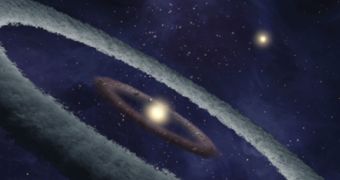At this moment there are 277 planets known to exist outside our solar system, most of which are either gas giants or too inhospitable for life. A very little number of these exoplanets have rocky surfaces or bear a small resemblance to our planet. Astronomers from the University of St Andrews in collaboration with colleagues from the US reveal that they have discovered a planet into its early formation stage, still surrounded by a cloud of gas and dust, which they believe to be the youngest planet ever discovered.
The young planet orbits a star dubbed HL Tau, located about 520 light years from Earth in the Taurus constellation. HL Tau is only 100,000 years old and is surrounded by an unusual bright and massive disk of matter, where planets may form. The discovery of this young planet, called HL Tau b, could provide scientists with valuable understanding on how planets form in material disks around other stars, because HL Tau b may be as young as only a few hundred years.
"The planet will probably take millions of years to settle down into its final form of something like Jupiter. So we really are seeing it very early - even a bit like the first cells that make up a human embryo in the womb," said Dr Jane Greaves from the School of physics and Astronomy at St Andrews.
The discovery was made with the help of a large array of telescopes located across the US, which produced very sharp images of HL Tau and the material disk surrounding it, revealing the presence of super-large rocky pebble-sized particles, evidence that the accretion disk is collapsing and already forming planets.
Nonetheless, astronomers were not quite expecting to find an actual planet in the making. In their images, something seeming to be a bright clump of matter appeared, which had also been observed in the previous years in the form of an unusual nebulosity.
"We see a distinct orbiting ball of gas and dust, which is exactly how a very young protoplanet should look. In the future, we would expect this to condense into a gas giant planet like a massive version of Jupiter. The protoplanet is about 14 times as massive as Jupiter and it's about twice as far from HL Tau as Neptune is from our Sun," added Dr Greaves.
According to Dr Greaves, the planet's formation might have been triggered by a gravitational instability produced by a nearby young star about 1,600 years ago. This instability determined some parts of the material disk to separate, cool down and condense into a self-contained structure. "Whether the protoplanet formed in only the last few hundred years, or sometime in the 100,000 years since the birth of HL Tau, the images provide a unique view of planet formation in action, and the first picture of a protoplanet still embedded in its birth material," said Greaves.

 14 DAY TRIAL //
14 DAY TRIAL //